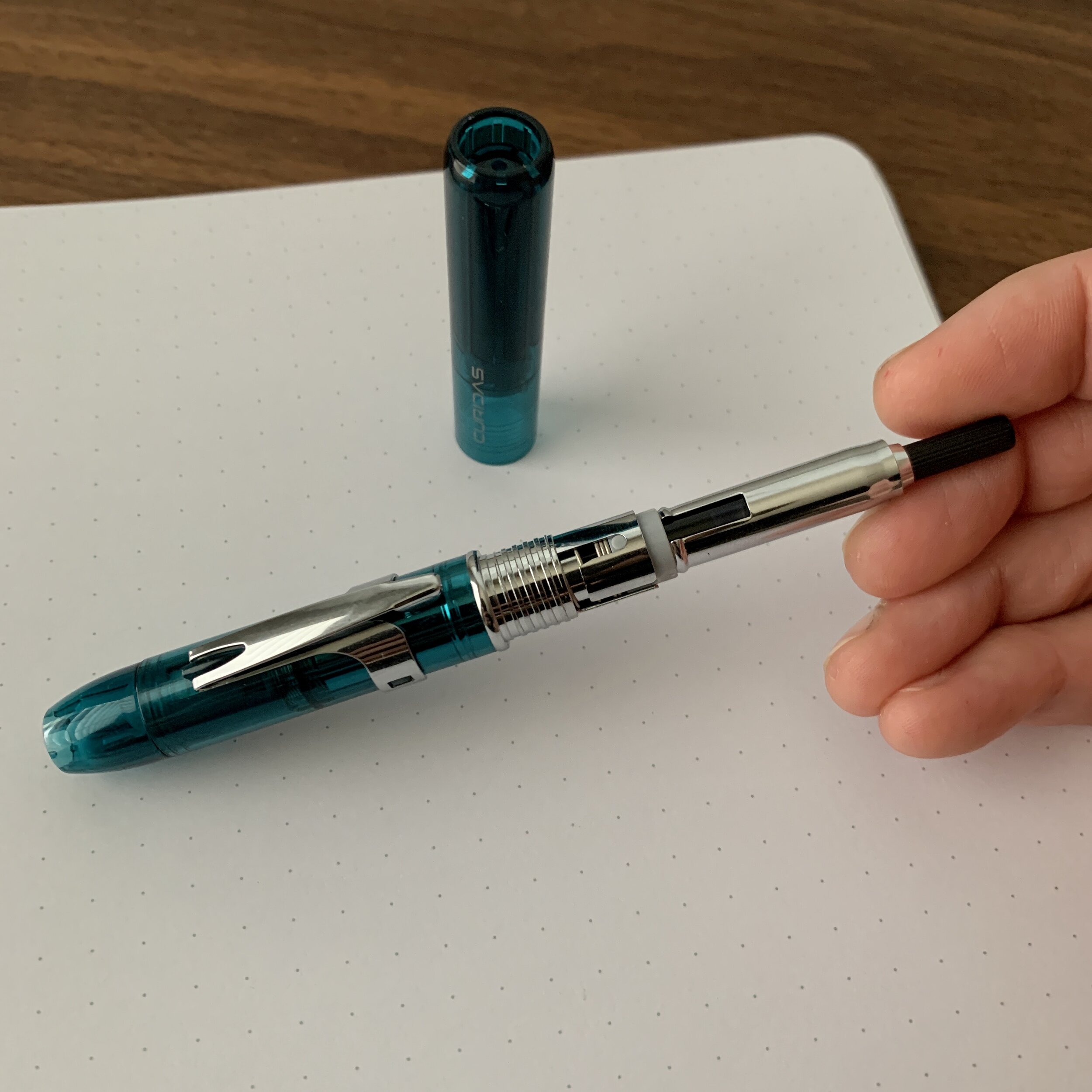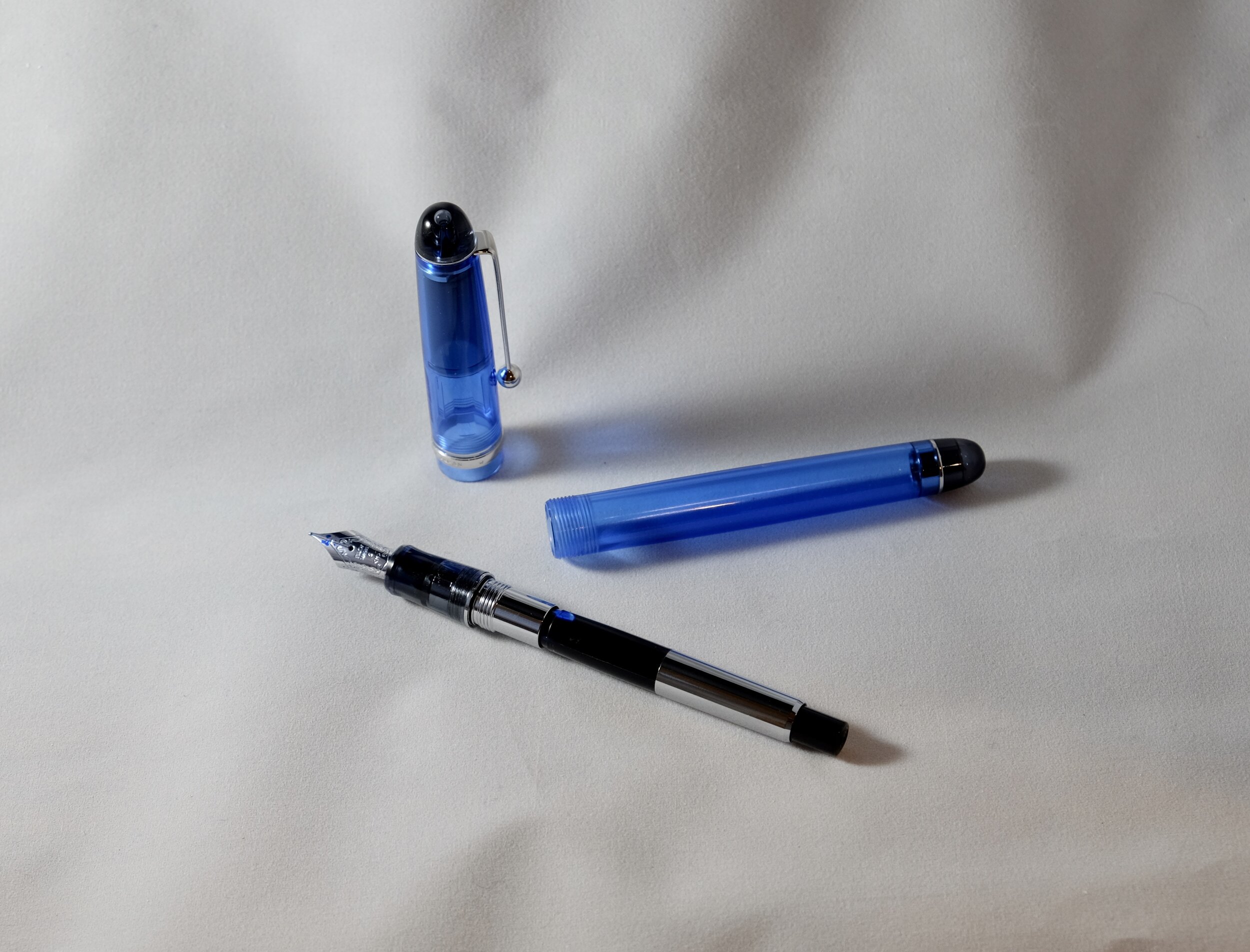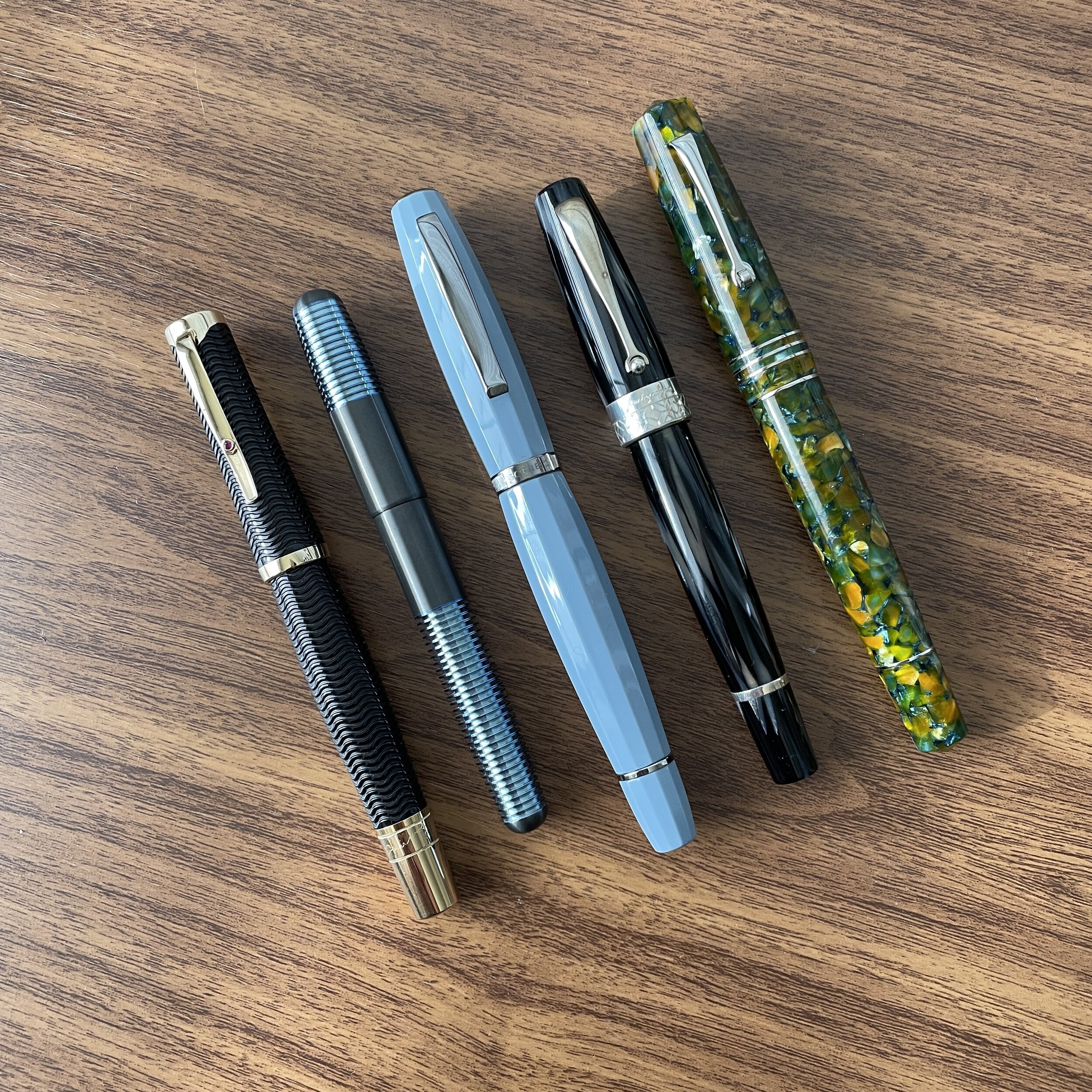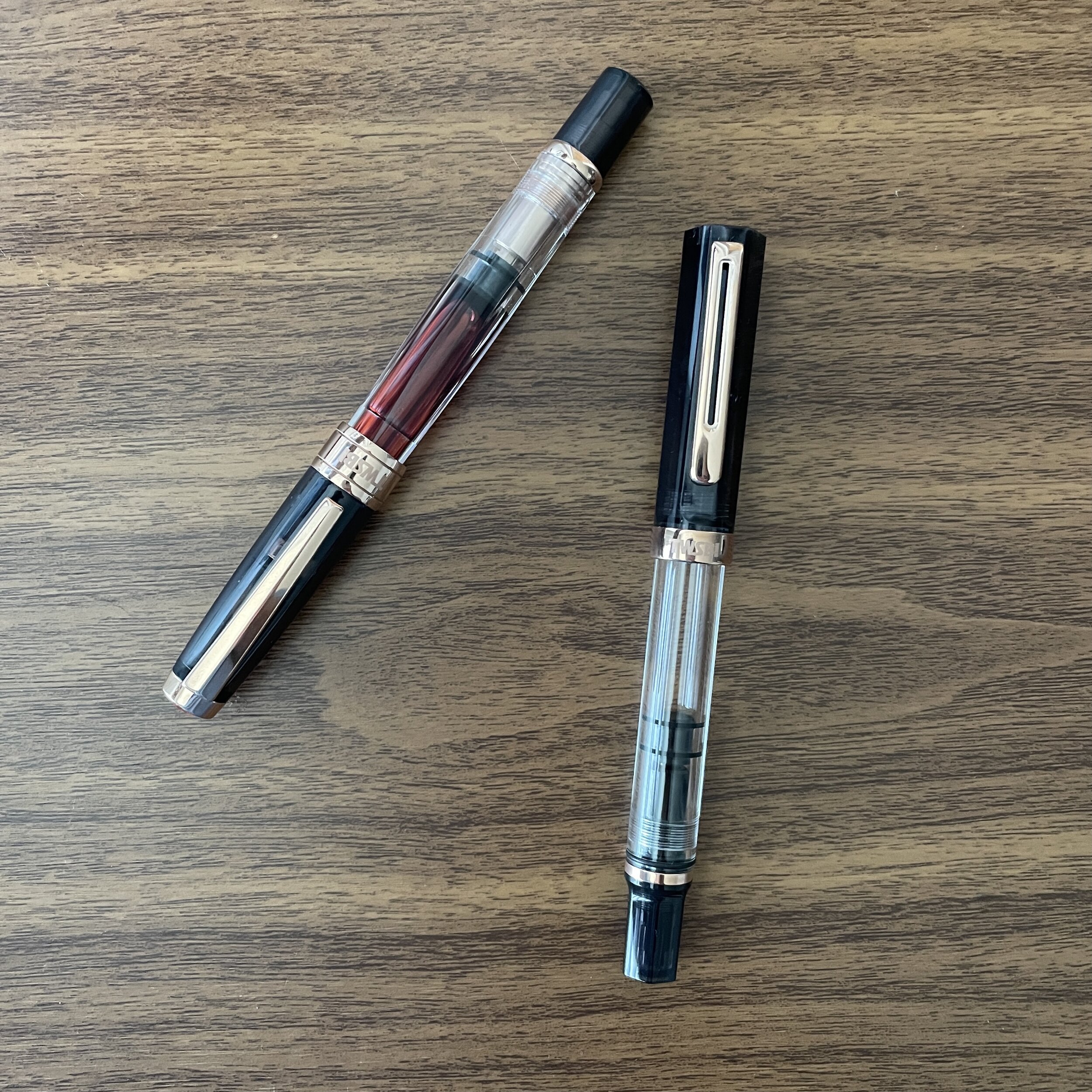Vintage vs. modern, steel nib vs. gold nib, extra-fine vs. triple-broad, Safari vs. Al-Star: the fountain pen community has always had - and always will have - various “debates” over what’s better. Of course there’s no right answer, but endlessly discussing the minutiae is part of what makes this hobby interesting, and the community so much fun. (Well, 99% of the community, setting aside the 1% that tends to take everything far too seriously.)
When it comes to my own personal collecting, my interests focus on two areas: materials (mainly celluloid) and filling systems. Acquiring pens made from rare and/or vintage celluloids, which have a depth and warmth that modern acrylics and resins lack, caters to the aesthetic/artistic interest I have in pens. On the other hand, exploring different filling systems brings out the true pen nerd in me, and is probably the reason I have an ever-expanding, wildly diverse accumulation of fountain pens. When manufacturers keep experimenting with new methods to fill fountain pens, you can’t help but try them all!
The Pilot Custom 74 fountain pen, featuring Pilot’s proprietary Con-70 Converter. While I love this particular converter, Japanese companies such as Pilot and Platinum (shown at the top) all use their own converter design, so you will need to buy separate converters fore each brand of pen.
Cartridge-Converter: The Best Filling System for Most People
People often ask me, what’s the best filling system for the everyday user? For the casual enthusiast, this answer is clear: Cartridge/converter offers a user-friendly, versatile mechanism that’s straightforward and especially appropriate for first-timers and those who travel a lot or otherwise need to be able to refill on the go. I enjoy many cartridge/converter fountain pens myself, and I certainly won’t pass on a pen that I otherwise find interesting or attractive simply because it’s not exclusively bottle-fill. Pros and cons of cartridge-converter filling systems include:
Pros:
Versatility. Cartridge/converter filling systems allow you to use ink cartridges and fill from an ink bottle. It’s not just about whether you’re a beginner - I’ve been in this hobby a decade or more, and still keep cartridge/converter fountain pens in rotation because they’re great for travel. (You can read more on why I like ink cartridges here.)
Ease of use. If you’re new to fountain pens and simply want to get to writing without worrying about making a mess learning to fill from a bottle, just pop in a cartridge and you’re on your way.
Easy to Clean. Cartridge/converter pens are also exceptionally easy to clean by flushing them out with an inexpensive bulb syringe, or soaking the nib unit in water or running it through an ultrasonic cleaner. If you enjoy using highly saturated or shimmer inks that might stain or otherwise be hard to clean out of a pen, cartridge/converter pens are typically the way to go.
Cons:
Small Ink Capacity. Both cartridges and converters generally hold less than 1ml of ink. On a busy day, I can easily write one or more cartridge/converter pens dry. If you enjoy changing inks frequently, you might view this as a “pro,” but high-volume writers looking to go a full day or more on a single fill might prefer something with a bigger ink capacity.
Proprietary Cartridges and Converters. While some pen companies have moved towards a universal, standard international converter that is freely interchangeable between different pens, many major brands (including Pilot, Platinum, Sailor, Lamy, and Parker, just to name a few) use proprietary cartridges and converters that only work in their pens. To add insult to injury, many pens don’t actually ship with a converter, so it creates an added expense when you can’t use one of the dozens of converters already in your desk drawer.
Limited Ink Selection. If you stick to cartridges, you won’t have as many ink options. Don’t get me wrong, you’ll still have plenty, as brands like Diamine, Herbin, Sailor, and Caran d’Ache release more of their ink lines in cartridge form, but you’ll likely be excluded from most of the boutique and specialty inks unless you buy the converter and fill from a bottle.
Many piston filling fountain pens are larger, to maximize ink capacity. The smaller pens, second from left and second from right, are cartridge converter, and the rest are piston-fill.
Piston Fillers and Vacuum Fillers Are More Fun
Even though I’m not a true filling-system snob, and frankly the majority of the pens I use on a daily basis are still cartridge-converter, I get the most enjoyment out of my piston and vacuum fillers. For those who may be new to fountain pens and unfamiliar with the terminology, a piston filler uses, well, a piston mechanism to draw ink into the pen when you dip the nib into an ink bottle and rotate the piston knob. A vacuum filler, such as the Pilot Custom 823 or TWSBI Vac 700R, takes in ink when you submerge the nib-end of the pen in an ink bottle and depress a plunger to create negative pressure. Both types of pens hold more ink than your typical cartridge/converter pen because the entire pen body becomes an ink reservoir, as opposed to a smaller plastic tube (i.e., a cartridge or converter) inside the barrel. In my opinion, this increased ink capacity is the primary benefit.
But piston fillers don’t need to be expensive. TWSBI makes a wide range of piston filling fountain pens for as little as $32.
That said, another huge part of why I love writing with a fountain pen is a sense of not just nostalgia but continuity - there’s something inspiring and even motivating about filling a pen and writing the same way that people did nearly a hundred years ago. For this reason, after cartridge/converter, piston fillers are probably the second most-represented category of fountain pens in my own collection, and what I recommend to most people as a first “upgrade,” followed by the vacuum filler.
Pros:
Huge Ink Capacity. Piston fillers and vacuum filler fountain pens can easily hold up to 2ml of ink per fill, and sometimes more. For me, that means I’m good to go for at least two full days of writing. Vacuum filler pens can hold a bit more ink, but as I discuss below, sometimes these are a bit more difficult to fill to capacity.
Sustainability/Less Waste. Using a fountain pen that exclusively fills from an ink bottle creates less plastic waste than using a cartridge/converter system. Even if you use the converter, those don’t last forever, as I note above, requiring replacement. If you’re focused on using fountain pens because you like the idea of not contributing to the endless morass of disposable ballpoints, rollerballs, and gel pens clogging landfills, then you may want to take things a step further and forego cartridges and converters.
Typically Higher Quality. Because piston and vacuum filling systems take more work to build, as a general matter these filling systems are found in higher-quality pens that may or may not be a pen company’s “flagship” pen. A piston or vacuum filling system is typically built to withstand the test of time, whereas I’ve had converters wear out or break in less than a year. Again, this is a generalization - there are very high quality cartridge-converter pens out there, and some very badly made complex filling systems, but overall I find this accurate.
Cons:
Generally More Expensive. With greater complexity and quality often comes greater expense. TWSBI and PenBBS are the two main exceptions to this rule, with TWSBI making both high-quality piston and vacuum fillers for well under $100. While PenBBS makes an exceptional vacuum-filling fountain pen (the No. 456), their pistons leave something to be desired.
Only Uses Bottled Ink. If you want to be able to refill one of these pens while you’re traveling, you’ll either have to bring a bottle of ink or a traveling inkwell. That can be an inconvenience for some, myself included, and I often opt for cartridges when I travel, or I make sure to fill one of my larger vacuum filler pens to capacity before I leave.
Messier to Fill and More Difficult to Clean. Cartridge/converter pens are easier to clean because you can simply unscrew the nib section and flush water directly through the feed. In a piston or vacuum filler, you basically have to work the piston or plunger mechanism multiple times until the water runs clear, which can take a while. This can be a real pain, especially if you’re changing colors. Moreover, any time you fill the pen from an ink bottle, you have the risk of a spill, which doesn’t exist with a cartridge.
The Pilot Custom 823 is probably my favorite vacuum-filler.
You can see the plunger rod through the transparent barrel. For a demonstration of how to fill a vacuum-filler pen, Matt’s video over at The Pen Habit has a useful demonstration.
Yes, I Know There Are Other Options Out There
Including eyedroppers, pump/vacumatic fillers, aerometric, bulk/syringe fillers, magnet fillers, etc. But other than maybe the Opus 88 Japanese-style eyedropper system (which I very much like), the three filling systems I’ve discussed here are the ones most pen users are likely to encounter on a regular basis, especially those new to the hobby. I may even publish a follow-up post on some of the less common variants, and video demonstrations of how exactly to fill and clean each type of pen.
What are your favorite filling systems, and why? Does anyone stick to just one? I want to hear from you!
This post does not contain affiliate links. The Gentleman Stationer is supported exclusively by subscribers to the T.G.S. Patreon and via purchases from the T.G.S. Curated Shop.



